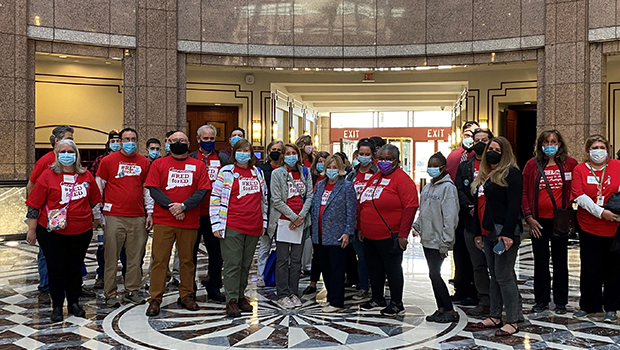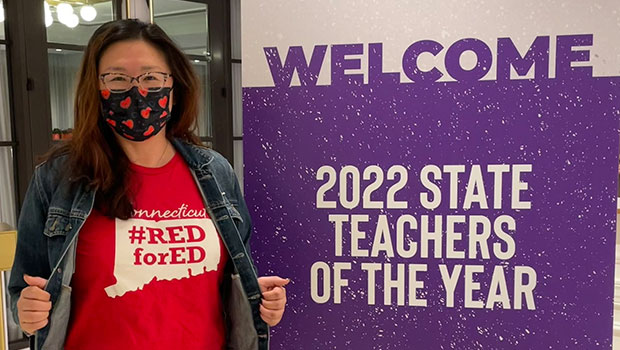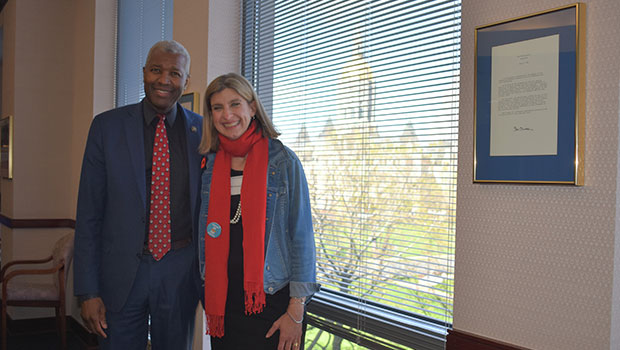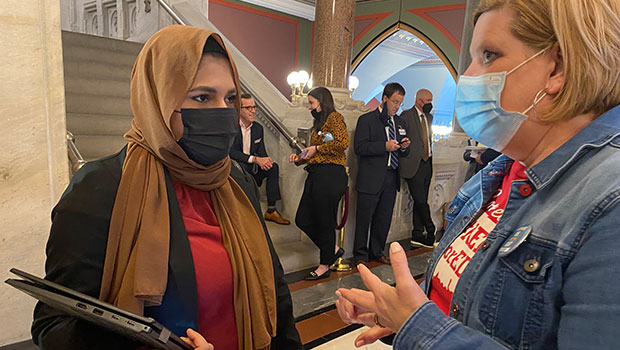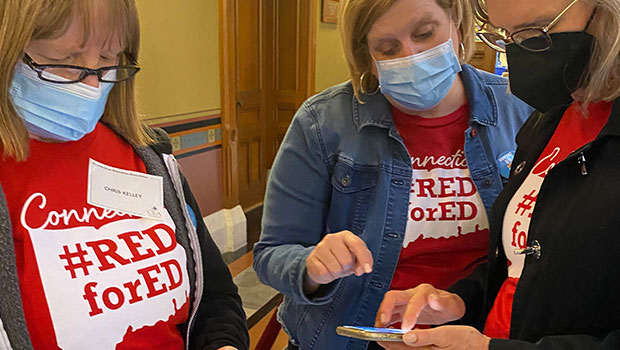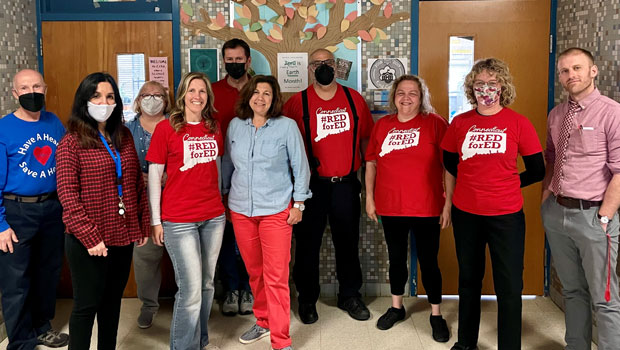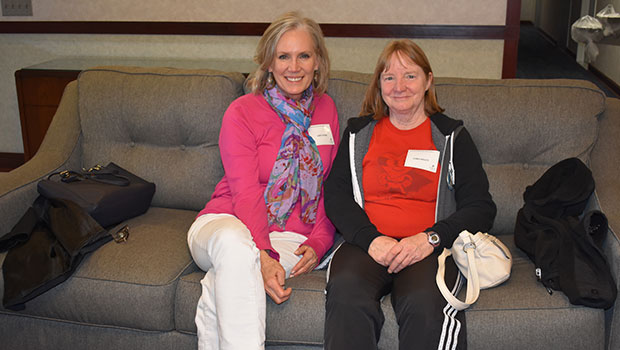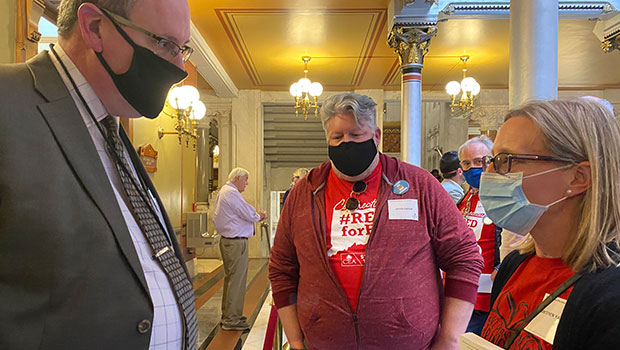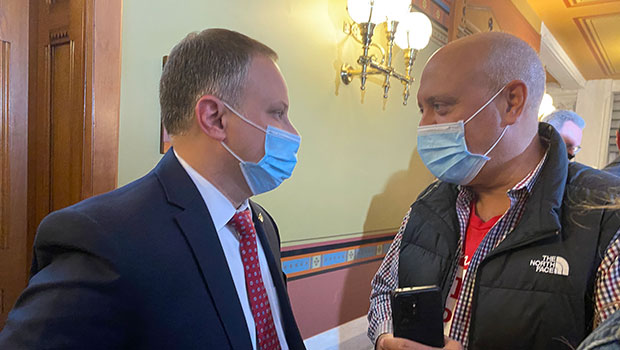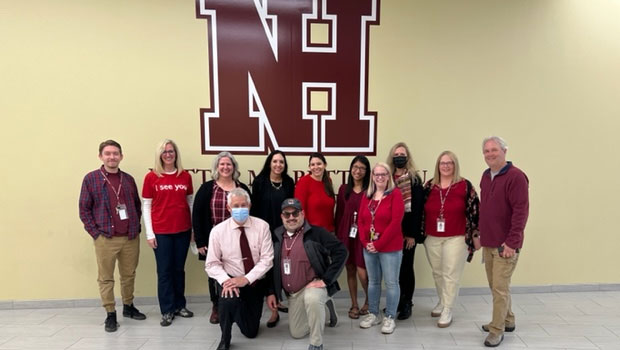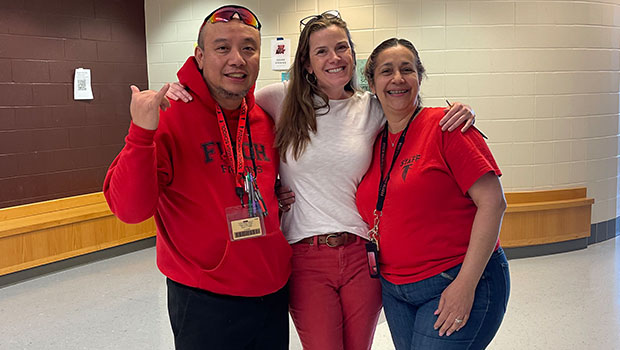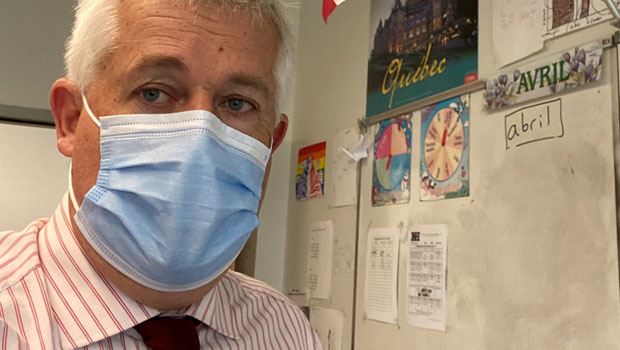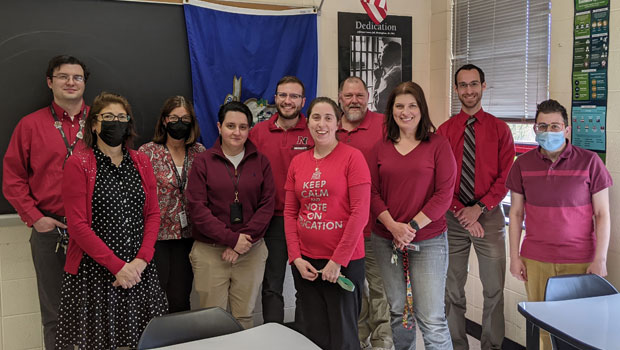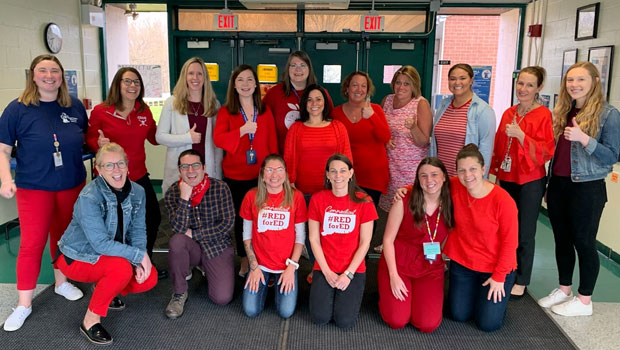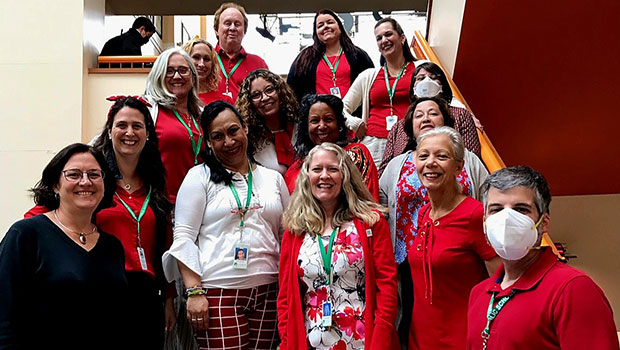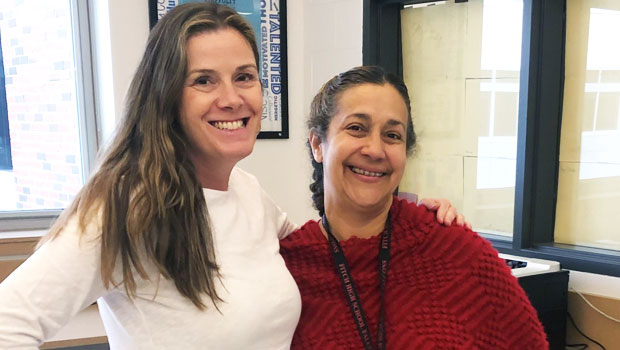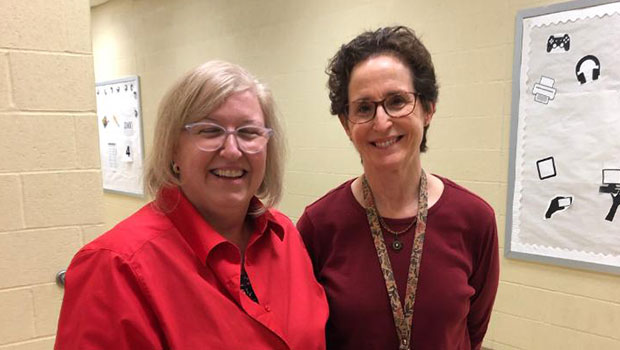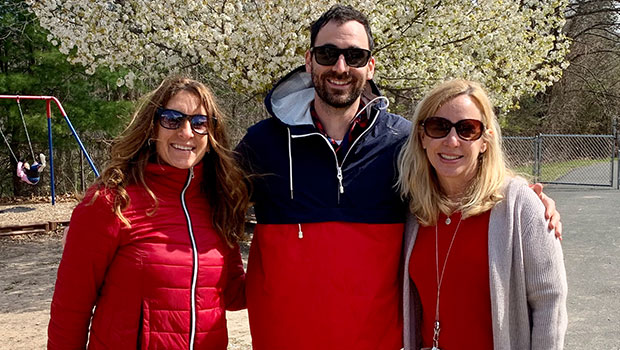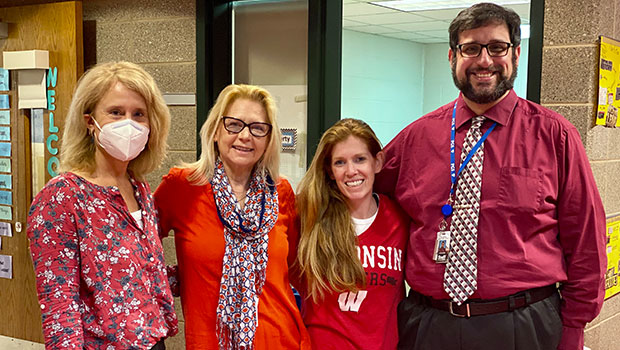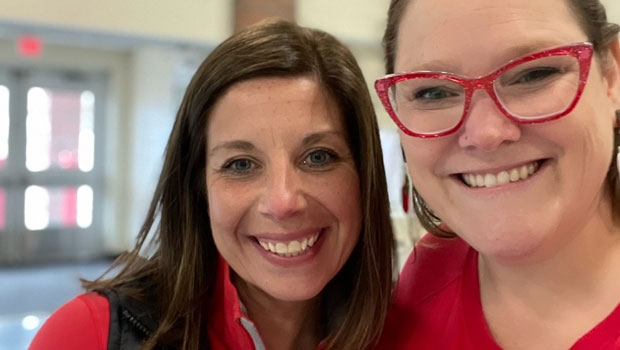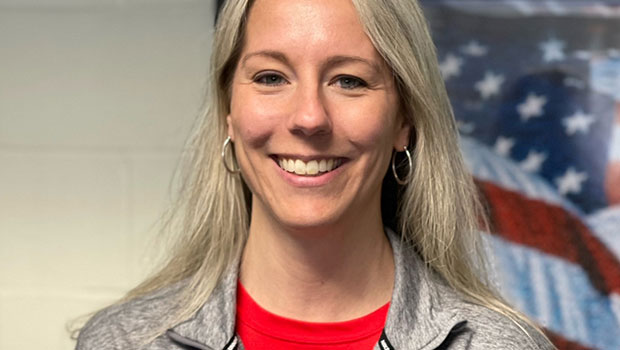In CEA’s statewide Red for Ed Day of Action, educators from small suburbs to cities with dozens of schools and tens of thousands of students called, emailed, and held in-person meetings with state senators and representatives in a final push to pass legislation critical to public schools.
Hundreds tweeted, posted, and wore red to school to raise awareness of the issues, and a number also spoke to reporters. Districts making it a red-letter day included Andover, Bridgeport, Cheshire, Columbia, Cromwell, Danbury, East Hampton, Greenwich, Groton, Hebron, Manchester, Marlborough, New Fairfield, New Milford, Newington, Norwich, North Haven, Plainville, Pomperaug, Scotland, Simsbury, Stratford, Wallingford, Waterbury, West Hartford, Westport, Windsor, and Woodbridge.
2022 Connecticut Teacher of the Year and Mansfield art teacher Kim King, who was at a White House reception hosted by the President and First Lady, tweeted, “Even though I can’t be in CT on our day of action, I’m wearing #RedforEd to support teachers, students, and families across our state. #indoorairquality #teacherrelief #mentalhealthsupport #no2dualteaching.”
In a morning interview with NBC Connecticut, 28-year veteran Litchfield High School teacher Lynn Scazzofava described the problems associated with dual instruction—a pandemic practice CEA is asking legislators to prohibit.
The option for dual instruction, which puts educators in the untenable position of trying to teach remote and in-person learners simultaneously, persists in some districts for reasons that include conflicts with sports or family vacations.
“Everything is taking three times as long to do,” Scazzofava said. “We also don’t have the opportunity to engage on a deeper level with the content, because we’re always trying to troubleshoot the technology.”
“It’s a fundamentally bad practice that cuts off students from their school experience and disengages rather than engages them,” CEA President Kate Dias told reporters.
Help needed
Dias also described the need to pass legislation establishing better ratios of students to certified mental health professionals in schools, noting, “We’re the first line of defense on mental health issues. Right now we’re in a triage situation where our school social workers, counselors, and psychologists are responding to issues as opposed to preventing. If we want to get into preventative efforts, we need more staff.”
However, educators are leaving the profession in greater and greater numbers.
Old Saybrook reading interventionist Judy Ayers and physical education teacher Chris Kelley, both of whom teach at Goodwin Elementary School, made the hourlong drive up to Hartford to speak with legislators about the recent exodus of qualified teachers and the ways lawmakers can stem the tide.
“Both of us came to teaching as a second career and have made sacrifices to be in a profession we love, but we’ve seen how stressful it is and how that’s made many of our colleagues—some of the most excellent teachers—leave the profession early,” said Kelley.
“We’ve lost really good teachers, and it doesn’t have to be that way,” said Ayers. “These past two years have been extremely difficult for so many teachers, and we’re also seeing the effects in the classroom of children who have missed out on a lot and are now learning to be learners. We’ve been in school teaching with masks on, we’ve had children behind plastic dividers, we’ve put our own health at risk, with elementary students being the last to be vaccinated, and we’ve done our best to keep them safe and protected. There were days when it was scary. I want legislators to realize that we were up every morning, we were in our classrooms, preparing our rooms, and teaching students who were at their desks or sitting on the rug while also teaching those behind computer screens at home or in the room of a hotel where a parent works as a cleaner. Teaching this way went above and beyond what you would normally expect. We’re watching a lot of colleagues leave the profession. We just had a colleague who was an outstanding teacher, well under the retirement age, take early retirement.”
Ayers and Kelley are asking legislators to end dual teaching and support a pandemic service credit for educators that acknowledges the high level of additional stress and work that went into teaching and counts that time as extra toward their retirement.
Showing up for students, colleagues
Also making the hour-plus drive to Hartford was Stamford’s Northeast Elementary School teacher Marilyn Schlosser, who pressed upon lawmakers to do more to ensure teachers can work and retire with dignity.
“We’re educators,” she said. “I feel as though unless you’re in the profession, you don’t know what we do for our students. It’s a very different world, and we want to be valued and appreciated.”
High school math teacher and Fairfield Education Association President Bob Smoler agreed.
“One of the reasons I came up here today is the pension service credit, which is of great interest to most of my members,” he said, “Teachers would feel good about getting extra credit for the Herculean effort of converting over to remote learning, then hybrid learning, then livestreaming, which was like learning your whole profession over again in a two-year period. Indoor air quality is another big issue for us. Both of our Fairfield high schools are 70 years old, and they don’t have air conditioning. In the early fall and late spring, it can get to 100 degrees in our classrooms, and we’re hoping the state will come through with funds that allow us to cool down those rooms and let students learn rather than just sweat it out in a hot classroom where nothing productive can really happen.”
Smoler added, “Of course, livestreaming—dual instruction—was never educationally appropriate. I understand why it happened, but kids aren’t really learning, because it’s impossible to teach those in front of you and those at home at the same time. We had a lot families take advantage of it. There were times when parents would take their kids up to Vermont and have them listen in to a livestream, and that wasn’t really good for the kids in the classroom, and it wasn’t good for the kids in Vermont. All of these issues are of particular interest to the members I represent, and I thought it was worth my time to come up here to advocate for them.”
“To support educators in order to have healthy air quality, to emphasize the value of a pandemic service credit, and to make sure dual instruction stays in the past—all of these priorities got me here today,” said CREC Education Association President Lisa Cordova.
“The past two years have been absolutely exhausting for teachers everywhere,” said Avon Education Association President Jon Moss. “More than ever, this is a time our legislators have an opportunity to show not only teachers but all constituents that they’re here to support public education in Connecticut, that they’re here to support teachers who tirelessly worked to make sure learning continued in unprecedented times and schools remained safe places where students could learn and teachers could teach.”
“We have a short legislative session here,” said Waterbury Teachers Association President Kevin Egan. “It’s super important for our teachers to activate, get together, and fight for the things we know can help keep us in this profession we love—a pension credit for teachers who worked during the pandemic, indoor air quality for many of our districts that unfortunately don’t have it. It’s issues like these that bring us up here and invigorate us to get over to the Capitol and advocate for our members.”
Teachers who met with their senators and representatives said the legislators welcomed them and listened carefully to their concerns.

